How to integrate SendPulse with other services via Make (formerly Integromat)
The Integromat service has changed its website address, design and name to Make. The integration options remain the same, but the design may differ from the screenshots shown in the article.
You can use Make (formerly Integromat) to create a scenario for automatically collecting, processing and transferring information from one service to another. SendPulse has 450 API methods for different services that you can use with the other 850 services and applications supported by Make.
In this article, we will show how you can use the SendPulse element to automate the transfer of information between services to establish communication with your clients.
Connecting the SendPulse element
You need to authorize requests to use the methods in the SendPulse API for integrations with other applications. To authorize your requests, you can use a token that you can get by sending the ID and Secret from your account settings in the API tab.
Add the SendPulse element, and choose a method. You can find more details about the choice of triggers and actions in the article.
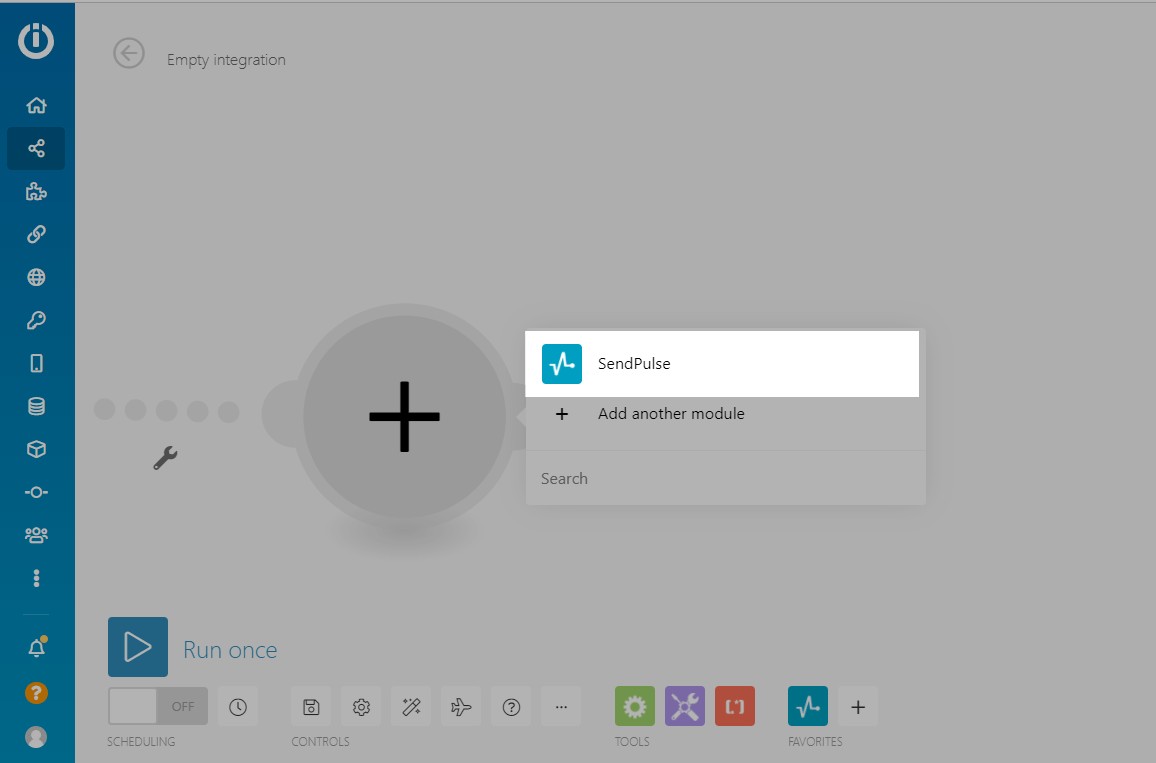
In the Connection field, click Add, and enter the ID and Secret from the API tab in the account settings in SendPulse.

Click Continue.
If you use multiple SendPulse accounts, you can rename your connection to differentiate between them.
You can review the list of connections, update permissions, and delete irrelevant connections in the Connections tab.
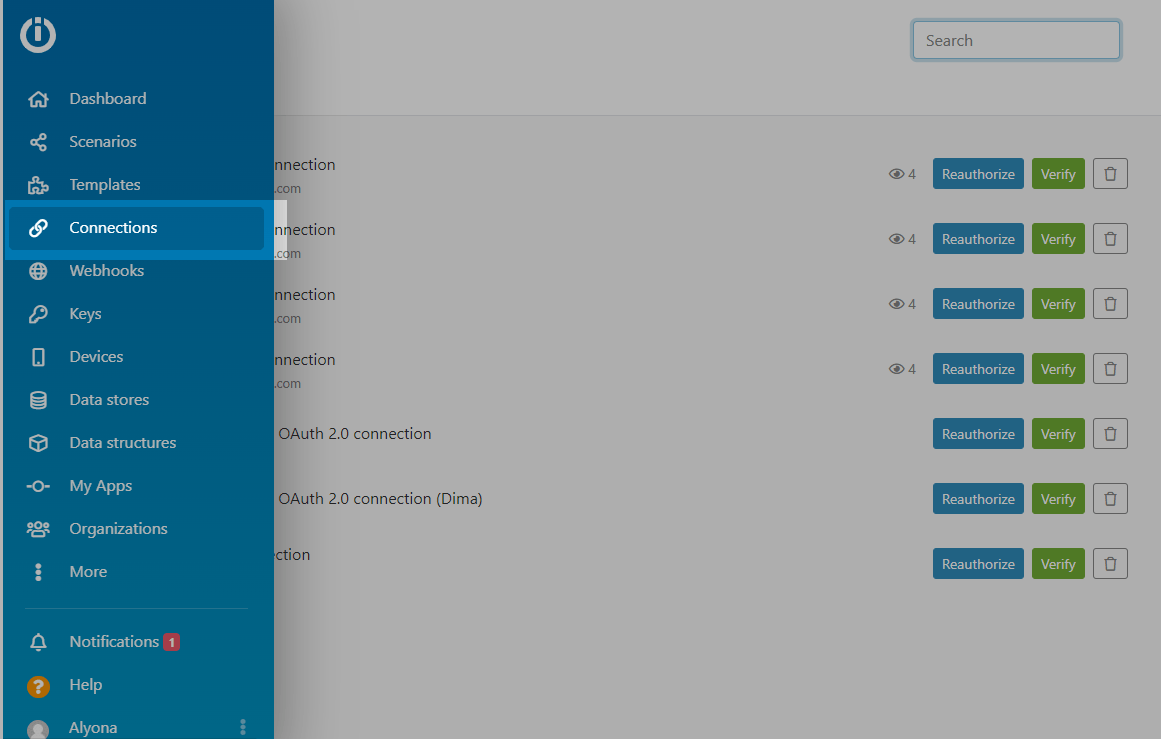
Module types
Make distinguishes different module types.
You can use the SendPulse elements as:
| Triggers | To run a scenario in Make to transmit information to other services |
| Searchers | To find information on services in SendPulse and use it in other elements and filters |
| Actions | To create or update information in SendPulse received from other elements. For example, to create a contact, you need to check the address for validity, send an email, SMS, Viber, push notification, or message via a chatbot, and create a deal in CRM and others. |
Triggers
The Make SendPulse: Watch Events element or the standard Make Webhooks: Custom Webhook element both serve as scenario triggers.
You can paste the webhook link into the following tracking locations:
| ChatBot settings in the Webhooks tab | Use global webhooks to send data about the following subscriber actions across all chatbot flows and feeds: bot subscriptions, incoming messages, outgoing messages, chat opens, starting a flow, following a link, and blocking the bot.
Read more about the structure of the received data: How to Send Webhooks Via Chatbots Have a look at some examples of how to use this webhook: |
| Chatbot flow builder, in the Action element with the Send webhook action | Use a webhook in the chatbot flow builder to transmit user data after the user has passed a scenario branch in a particular flow.
With this element, you can only transmit standard webhook variables, including chatbot and user variables. Read more about the structure of received data: How to Send Webhooks Via Chatbots Have a look at some examples of how to use this webhook: |
| Chatbot flow constructor, in the API request element | Use a webhook in the chatbot flow builder to transmit user data after the user has passed a scenario branch.
In contrast to the Send webhook action, in the API request element, you can set up your own structure and webhook data to be sent to the URL. Read more: How to send and receive data from external sources Have a look at some examples of how to use this webhook: How to Transfer Data from a Chatbot to Google Apps How to Create a Chatbot with a Booking System in Google Sheets How to Pass Personalized Data from a Google Sheets Row to a Chatbot |
| A360 flow builder with the Send webhook action | Use the webhook in the flow builder to send emails, SMS, Viber push notifications, and chatbot messages to transmit user data after a user passes a scenario branch in a certain flow.
With this element, you can only transmit standard webhook variables, including author and user variables. Read more about the structure of the received data: How to Set up Sending Webhooks to your System |
| Account settings in the API tab for the email service | Use global Email service webhooks to send data about the following email events: marked as spam, opened campaign, clicked link, new subscribers, deleted from mailing list, user unsubscribed, delivered, changed campaign status.
Read more about the structure of the received data: How to Enable Webhooks for Email Service |
| Account settings in the API tab to send via SMTP service | Use the Email service global webhooks to send data about the following email events : delivered, undelivered, open, clicked, marked as spam, unsubscribed.
Read more about the structure of the received data: How to Enable Webhooks for Transactional Emails |
To create a webhook link in Make, click the + on the starting element, and select the SendPulse element.
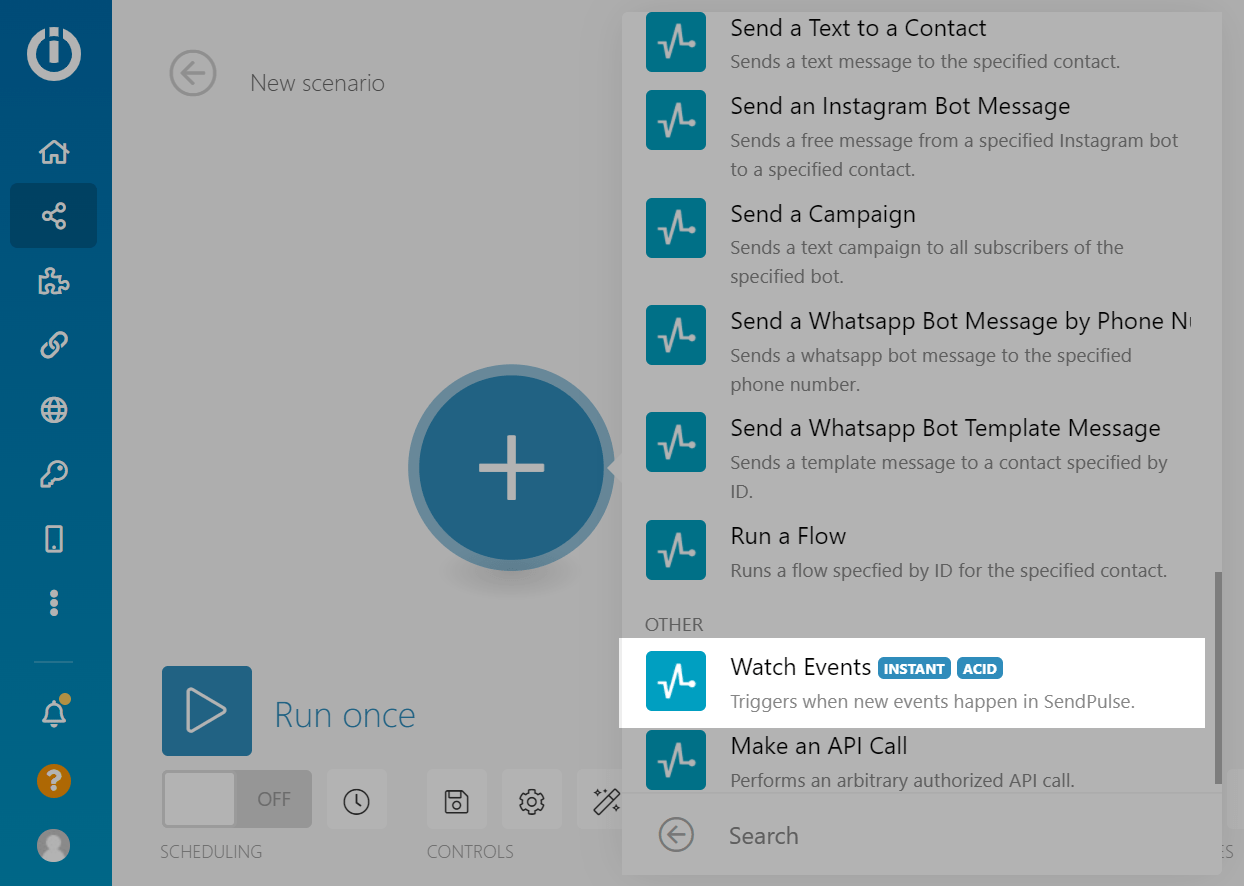
Log in to your SendPulse account, and copy the webhook link.
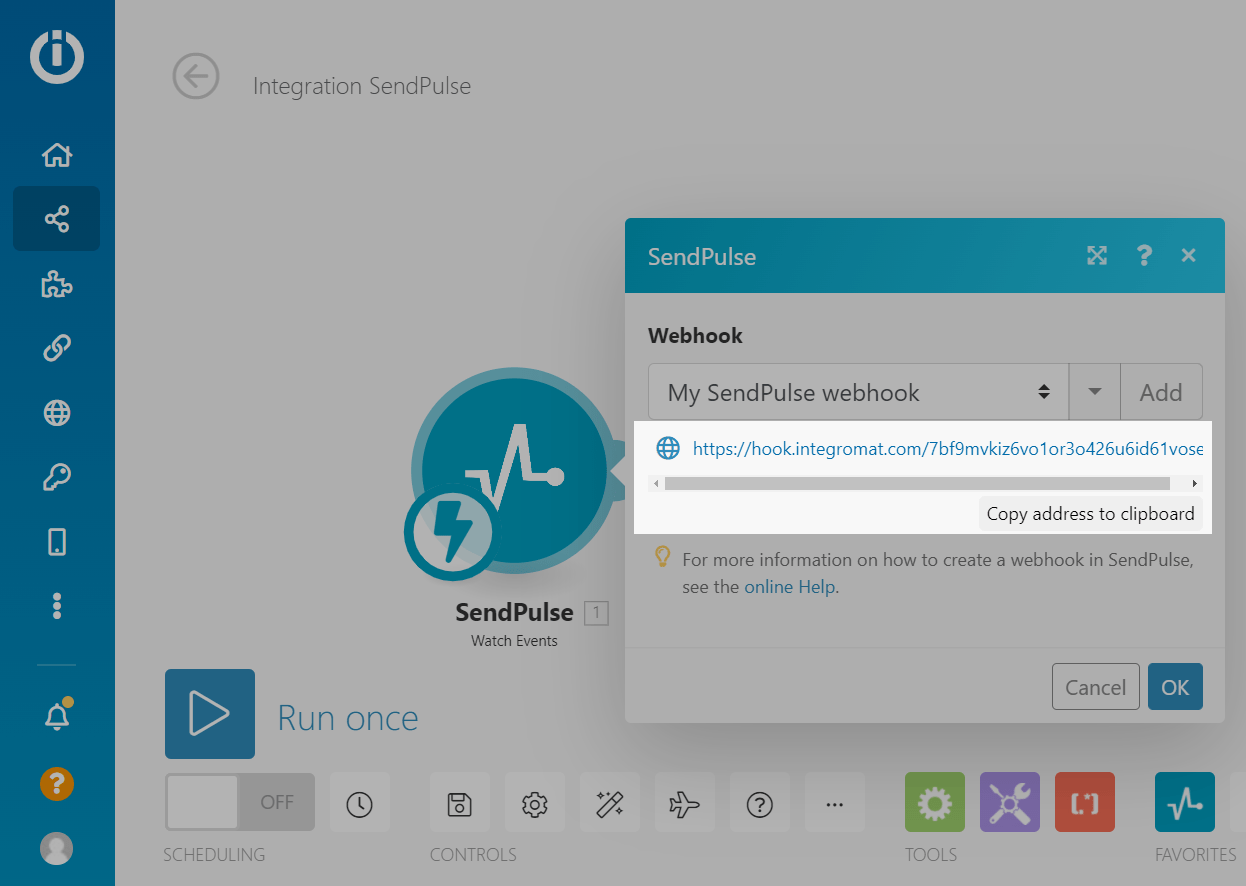
Search
To get information from the SendPulse service, you need to use the SendPulse element with the GET method action.
For example, you can request a list of active and blocked contacts, information on campaigns sent in Email, CRM, PUSH, and Chatbots, information on deals and pipelines in CRM, and information on chatbots and flows in Chatbots.
With Make, you can use ready-made search methods, or you can manually add any other method from the SendPulse API documentation using the SendPulse element with the Make API Call action.
In the SendPulse API documentation, you can also see sample responses for each method, so you can choose the method to get the right variables and use them in the next elements or filters.
Using the ready-made method
The following search methods have been added to Make:
| Email service | |
| List Contacts | Returns the list of contacts from the specified mailing list ID.
The Get a List of Emails from a Mailing List method is used. You can use it to get the |
| Search a Contact by Variable | Returns the list of contacts to the specified mailing list that has the variable you are looking for.
The method Get all of the Contacts in a Mailing List by Variable is used. |
| Search a Contact by Email | Returns the information about a contact in the specified mailing list.
The method Get Information for an Email Address from a Mailing List is used. |
| Get a Contact | Returns the information about the contact in all mailing lists.
The method Get General Information About a Specific Email Address is used. |
| List of Campaigns | Returns the list of campaigns with any sending status in the Email service.
The Get a List of Campaigns method is used. |
| Get a Campaign | Returns the information about a campaign by its ID using the Get Campaign Information method. |
| List bounces (SMTP service) | Returns the information about emails sent with the SMTP service that failed to deliver in the last 24 hours of the selected day.
The method Get Information About Bounces for a 24-hour Period is used. |
| Web Push | |
| List Website Subscribers | Returns the list of your site subscribers.
The Get a List of Website Subscribers method is used. |
| Get a Website | Returns the information about the site.
The Get an Information About a Website method is used. |
| Chatbots
* in the method box, you can choose a messenger chatbot (Instagram, Telegram, Facebook, or WhatsApp) |
|
| List Contacts by Tag | Returns the contact list.
The Get Contact List by Tag method is used. You can use it to get the |
| List Contacts by Variable | Returns the contact list.
The Get Contact List by Variable method is used. You can use it to get the |
To add an element using a ready-made method, select the SendPulse element with a method that starts with Get, List, or Search.
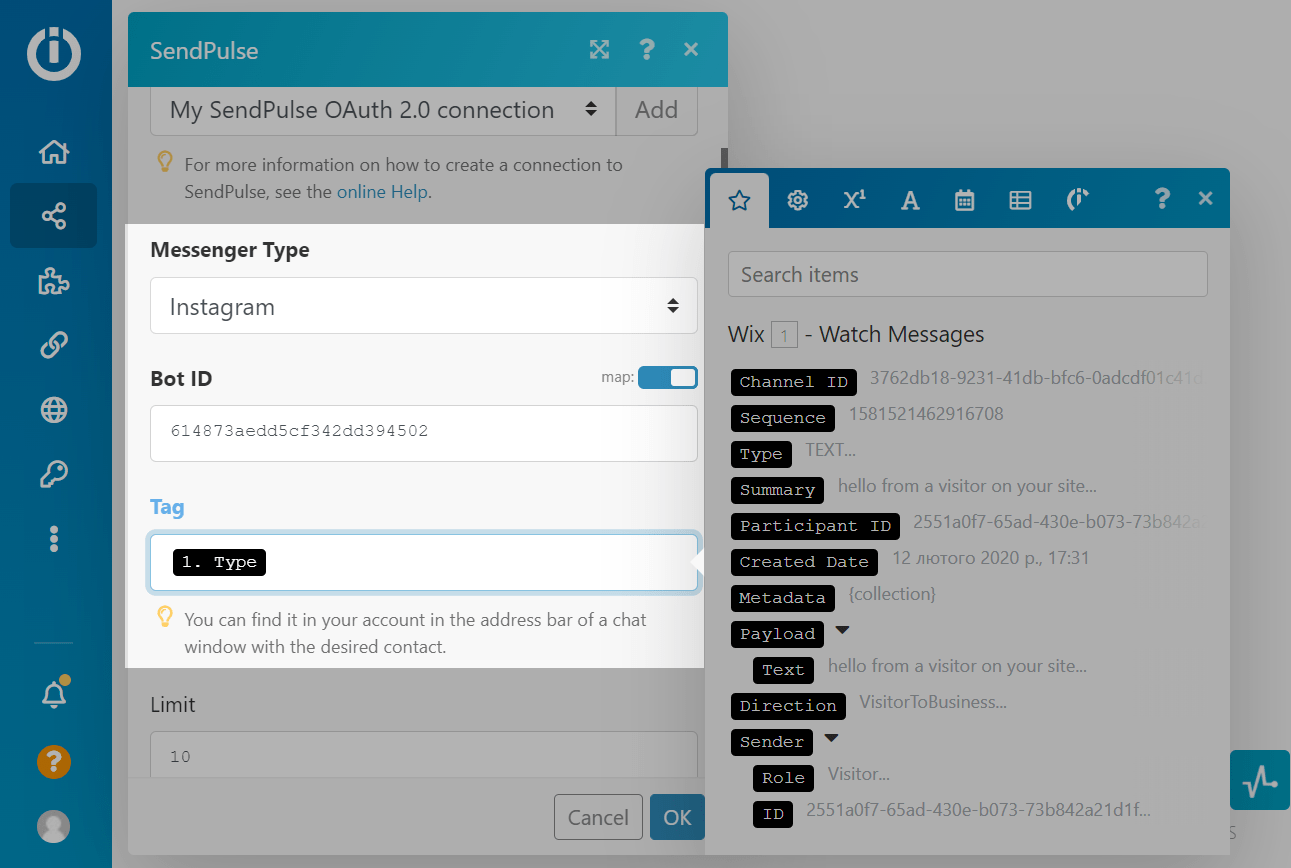
Fill in the fields by following the hints. You can insert a static value if you want to make queries with the same data or use dynamic values if you want to make queries with the value of the variables you got in the previous elements.
To use dynamic values, select the variable obtained in the previous elements.
If you don't have variables from the previous element, click Run once next to it, and play the event tracked by the element.
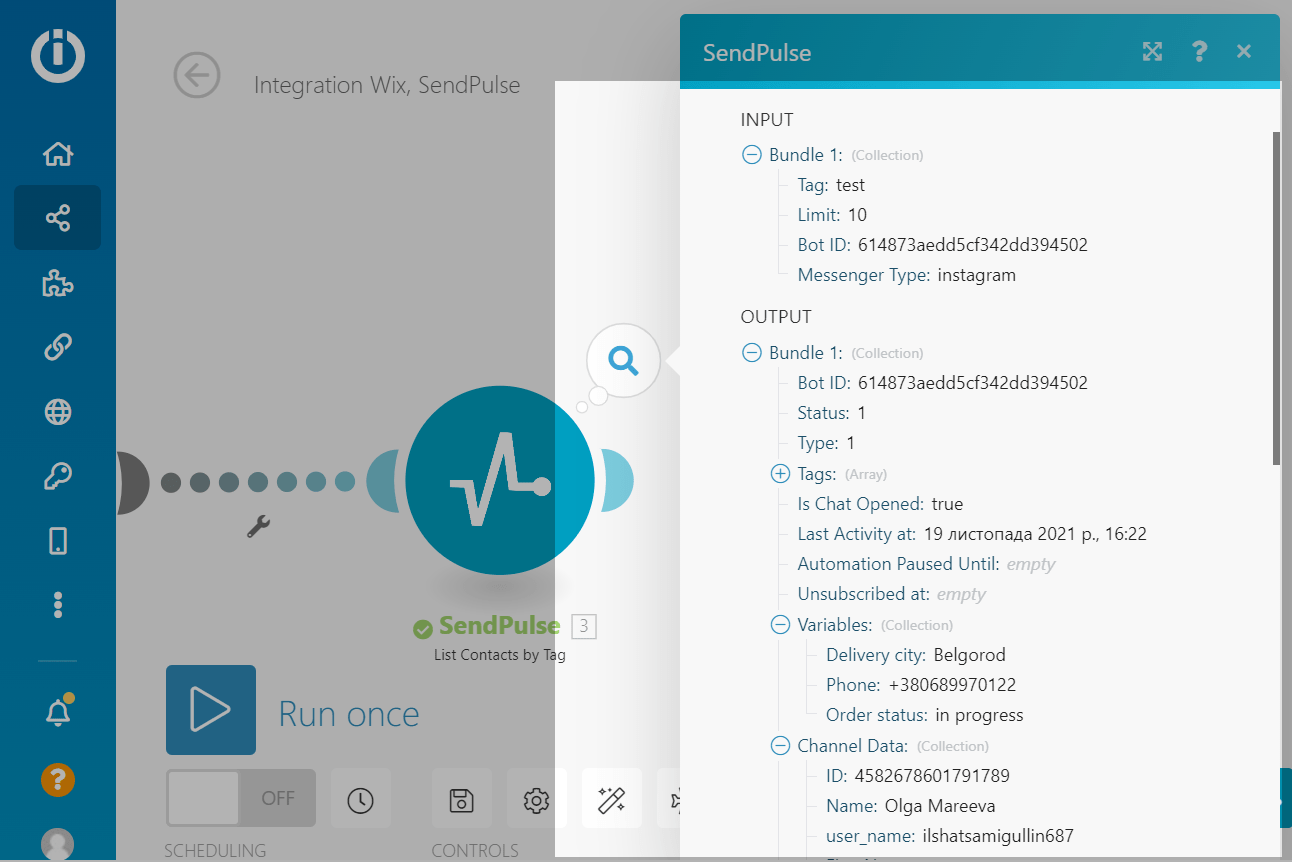
Checking the execution of the element
After you have configured the element, right-click on it, and select Run this module only. If you have used static values, you will immediately see the result of the data search. If you need to test the search for dynamic variables, click Run once, run the start event, and test the whole bundle.
To view the result, click on the number above the executed element.
Under Input you can view the data that was used to send the request. Under Output you can view the data that the element received after executing the request.

Using the manual method
To use a search method from the SendPulse API that is not on the list, select the SendPulse element with the Make API call method.
Fill in the fields, following the SendPulse API documentation on the method:
In the URL field, enter the request URL, and select a method.
For some methods, additional parameters that allow you to refine your data and narrow your search results are available.
In GET requests additional parameters are sent via the request URL.
To add a variable, enter the ? sign and the variable name, then enter the = sign and the variable value. To add second and third variables, enter the & sign and the name of the next variable.
For example, if we manually created a link to the request from the previous example with a ready-made request for the Get list of subscribers by tag method, the link would have the following look:
/instagram/contacts/getByTag?tag=test&bot_id=614873aedd5cf342dd394502.Where /instagram/contacts/getByTag is the query path, tag and bot_id are the names of the variables we searched for; the value with = is the value of the variables.
For the methods in CRM and Chatbots services, you can also fill in the fields and run the method directly on the API documentation page. Afterward, just copy the finished request link.
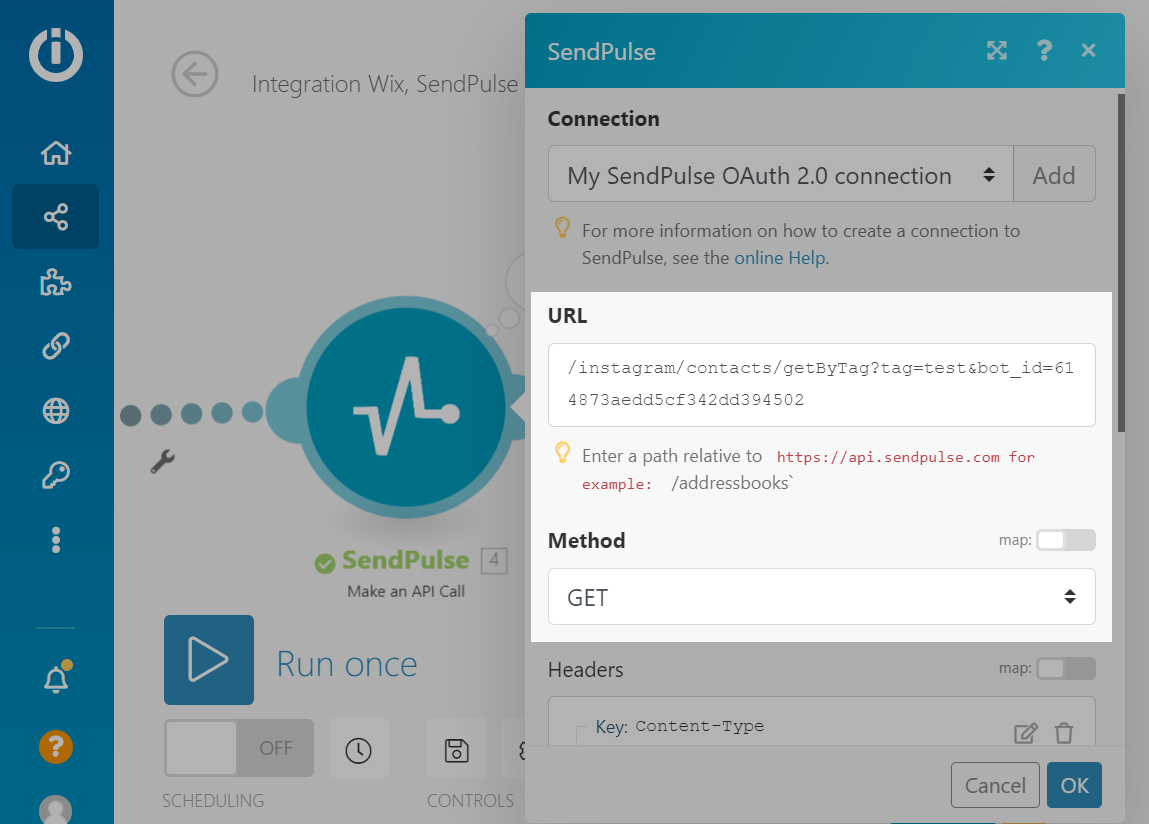
You can check the module the same way you check the execution of the element.
Here is a list of search methods that are not on the ready-made list, but you can use them as well:
| Email service | |
| Get a List of Variables for a Mailing List | Returns the list of variables in the specified mailing list. |
| Get Information About a Template | Returns the contents of the email campaign template and other information about it. |
| Get a List of Templates on an Account | Returns the list of templates in your account. |
| Get a List of All Senders | Returns the list of senders of email campaigns. |
| Get a List of Contacts in Blacklist | Returns the list of contacts who were added to the blacklist. |
| Get Your Balance Information (general and detailed information) | Returns the information about the balance status in your SendPulse account. |
| Get a List of Webhooks | Returns the list of sent events on a sent email. |
| Get Statistics about an Automation Flow
(and all other methods from this section) |
Returns the information on flows and all elements in the A360 flow. |
| SMTP | |
| Get a List of Emails | Returns the list of emails sent via SMTP. |
| Get Information About a Specific Email | Returns the information on the specified email. |
| Get a List of Unsubscribed Users | Returns the list of contacts who have unsubscribed. |
| Get a List of Sender’s IP Addresses (as well as sender and domain addresses) | Returns the information on the restrictions that are used when sending emails: the allowed IP address, the validated address, or the domain. |
| Verifier | |
| Get a List of Verified Mailing Lists | Returns the list of mailing lists with verification information for each of them. |
| Push | |
| Get a List of Sent Web Push Campaigns | Returns the list of sent PUSH campaigns. |
| Get a List of Variables for a Website | Returns the list of variable subscribers in a site's audience.
Read also: How to Pass Additional Variables for Segmenting and Personalizing of Web Push Notifications |
| SMS | |
| Get Information for a Specific Phone Number | Returns the information from the specified mailing list about the requested number. |
| Get a List of Contacts in the Blacklist | Returns the list of contacts that are added to the blacklist. |
| Get a List of Campaigns by Date | Returns the information on campaigns sent. |
| Calculate the Cost of a Campaign | Returns the information about the estimated value of a company. |
| Get List of Sender IDs | Returns the information about sender names and their confirmation status. |
| Viber | |
| Get a List of Campaigns | Returns the list of Viber messages. |
| Get a List of Sender Names | Returns the list of sender names in Viber including their status and traffic type. |
| Get Statistics on a Campaign | Returns the total email campaign performance statistics. |
| Get a List of Viber Campaign Recipients | Returns the list of recipients with the sending status for each number. |
| CRM | |
| Get a list of pipelines | Returns the list of pipelines and information about each of them.
You can use it to get |
| Get information about a pipeline | Returns the information about the specified pipeline. |
| Get a list of deals | Returns the list of deals and information about each of them.
Note that the method uses a lot of additional filter parameters for searching, and therefore the parameters are sent via body using thePOST method. You can find a description for each parameter under the "Request body" field in the "Shema" tab. You can use it to get the |
| Get information about the deal | Returns the information about the specified pipeline. |
| Get a list of deal notes | Returns the list of comments with information about each one. |
| Get a list of contacts | Returns the list of contacts and information about each of them.
Note that the method uses a lot of additional filter parameters for searching, and therefore the parameters are sent via body using the POST method. You can find a description for each parameter under the "Request body" field in the "Shema" tab. You can use it to get the |
| Get information about a contact by ID | Returns the information on the specified contact |
| Get all contact deals | Returns the list of pipelines of the specified contact. |
| Get a list of contact tags | Returns the list of contact tags with information about each of them. |
| Get deal fields by ID | Returns the list of deal fields. |
| Get contact fields | Returns the list of contact fields. |
| Get a list of team members | Returns the list of active invited users. |
| Chatbots
*The methods used for all messengers (Instagram, Telegram, Facebook, or WhatsApp) are identical.However, there are additional methods for some messengers. |
|
| Get a list of connected bots | Returns the list of bots and information about each of them.
You can use it to get |
| Get information about a contact by ID | Returns the information on the selected contact. |
| Get information about a contact by phone number (WhatsApp only) | Returns the information on the selected contact
You can use it to get |
| Get remaining time for automation pause | Returns the time and date before which auto-flows are stopped for a contact. |
| Get a list of variables | Returns the list of variables in the selected chatbot with information about each of them.
You can use it to get |
| Get a list of flows | Returns the list of flows created in the selected bot and information about each of them.
You can use it to get |
| Get a list of triggers | Returns the list of created triggers in the selected bot with information about each of them.
You can use it to get |
| Get list of chats | Returns the list of chats with subscribers and the information about a contact and the last message received from them. |
| Get a list of messages | Returns the list of all messages in correspondence with the specified subscriber. |
Actions
To create a new object, update information about an object, or delete an object in the SendPulse service, you need to use the "SendPulse" element with action using the POST (create), PUT (update), and DELETE (delete) methods.
For example, you can create, update, or delete contacts, pipelines, deals, tags, send email, SMS, PUSH, Viber campaigns, chatbot messages, start flows, and more.
The actions can also include creating an event in A360. For example, you can send order or user registration data to the created URL using the POST method and trigger Automation360 or bot flows. You can copy the example of the acceptable structure in the request body when creating the event.
In Make, you can use ready-made search methods, or you can manually add any other method from the SendPulse API documentation using the SendPulse element with the Make API Call action.
In the SendPulse API documentation, you can also see request body samples to copy them and use sample responses for each method. You can do this in order to choose the method to get the variables you want and use it in the next elements or filters.
Using the ready-made method
The following action methods have been added to Make:
| Email/SMTP/Verifier | |
| Create/Update Contacts | Adds a new email address to the specified ledger using the single-opt-in or double-opt-in method or updates data on existing addresses.
The Add Emails to a Mailing List method is used. |
| Create/Update a Contact | Updates the variable value for the specified existing contact, specifying the variable type.
The Change a Variable for an Email Contact method is used to start the A360 flow by start trigger Change Variable. |
| Send an Email | Sends the email via SMTP.
If the request is successful, it returns the email ID. The Send email method with the HTML and text version of the email is used. |
| Send an Email from Template | Sends an email via SMTP with dynamic variables.
If the request is successful, it returns the email ID. The Send an Email method with the template ID of the email in the Email service is used. |
| Verify an Email | Checks the specified address for validity.
If the request is successful, it returns information about the validity status of the address. The Verify a Single Email Address and Get Email Address Verification Results methods are used sequentially. |
| Create a Template | Creates a template in the Email service.
Returns the template ID on a successful request. The Create a Template method is used. |
| Push | |
| Activate/Deactivate a Website Subscriber | Activates the Push Subscriber you turned off or deactivates the Push Subscriber in the site's audience.
The Activate/Deactivate a Subscriber method is used. |
| Create a Push Campaign | Sends a Push notification to the audience of the specified site. To send a segmented campaign, specify additional audience filter fields.
The Create a New Web Push Campaign method is used. |
| Chatbots
* in the method box, you can choose a messenger chatbot (Instagram, Telegram, Facebook, or WhatsApp) |
|
| Set a Variable to a Contact | Sets or updates a variable to the specified contact in the audience of the selected chatbot.
The Assing a variable for a contact method is used. |
| Set Tags to a Contact | Sets tags to the specified contact in the audience of the selected chatbot.
The Add a tag to a contact method is used. Have a look at an example of how to use this method in the Add Tag Action paragraph of the article. |
| Send a Text to a Contact | Sends a text message to the specified contact.
The Send text message to contact method is used. Note that you can only send a message to Facebook, WhatsApp, and Instagram within 24 hours since the user's last message or interaction with the chatbot. |
| Send an Instagram Chatbot Message | Sends a text or picture message to the specified active contact on Instagram.
The Send free message to contact method is used. Note that you can only send a message to Facebook, WhatsApp, and Instagram within 24 hours since the user's last message or interaction with the chatbot. |
| Send a Campaign | Sends a campaign to the audience of the selected chatbot.
The Send campaign method is used. Note that you can only send a message to Facebook, WhatsApp, and Instagram within 24 hours since the user's last message or interaction with the chatbot. |
| Send a WhatsApp Bot Message by Phone Number | Sends a free message to the specified phone number on WhatsApp.
The Send free message to contact by phone number method is used. Note that you can only send a message to Facebook, WhatsApp and Instagram within 24 hours since the user's last message or interaction with the chatbot. |
| Send a WhatsApp Bot Template Message | Sends a template message to a specified phone number or subscriber ID in WhatsApp.
The Send a template message to contact by phone number method is used. Have a look at an example of how to use this method in the article: Action "Send Template Message to Phone. |
| Run a Flow | Starts a flow by the flow ID, sending it to the specified contact.
The Start flow by its identifier method is used. |
To add a element using a ready-made method, select the SendPulse element with a method that starts with an action verb, creating or changing the object property: "Create," "Update," "Send," "Run," "Verify," "Unsubscribe," and "Set."
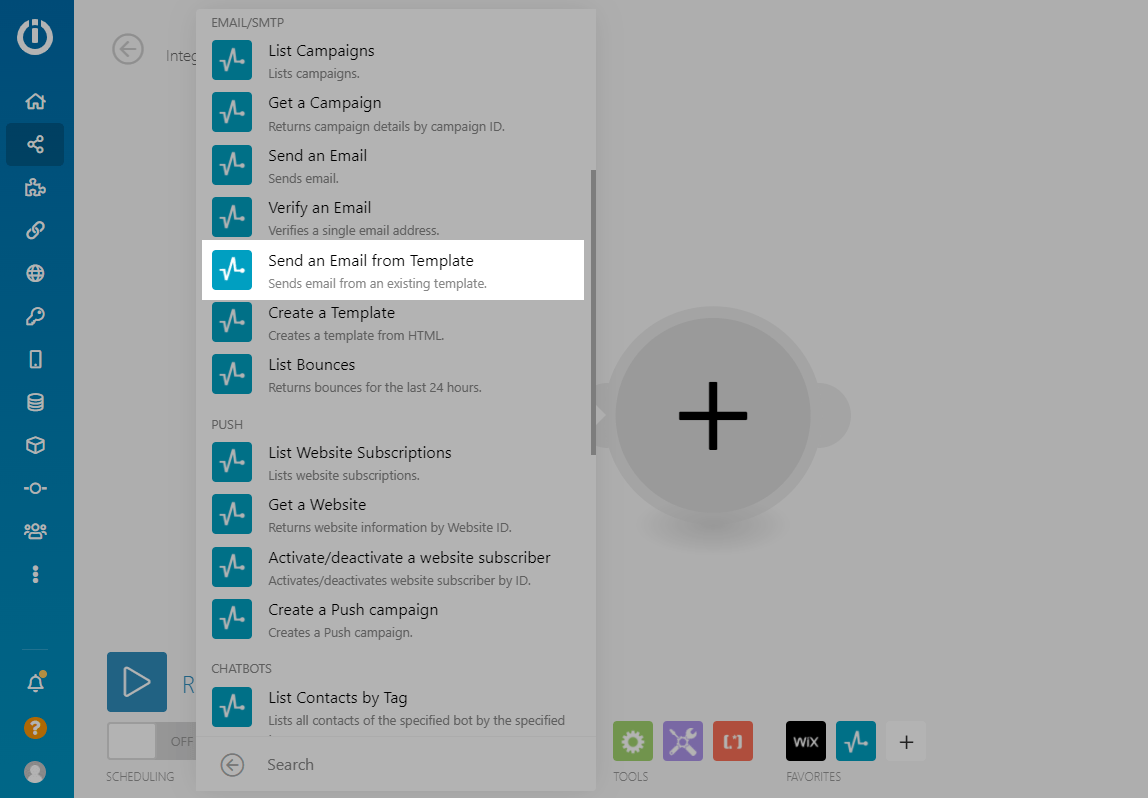
Fill in the fields, following the hints. You can insert a static value if you want to make queries with the same data or use dynamic values if you want to make queries with the value of the variables you got in the previous elements.
To use dynamic values, select the variable obtained in the previous scenario elements.
If you don't have variables from the previous element, click Run once next to it, and play the event tracked by the element.
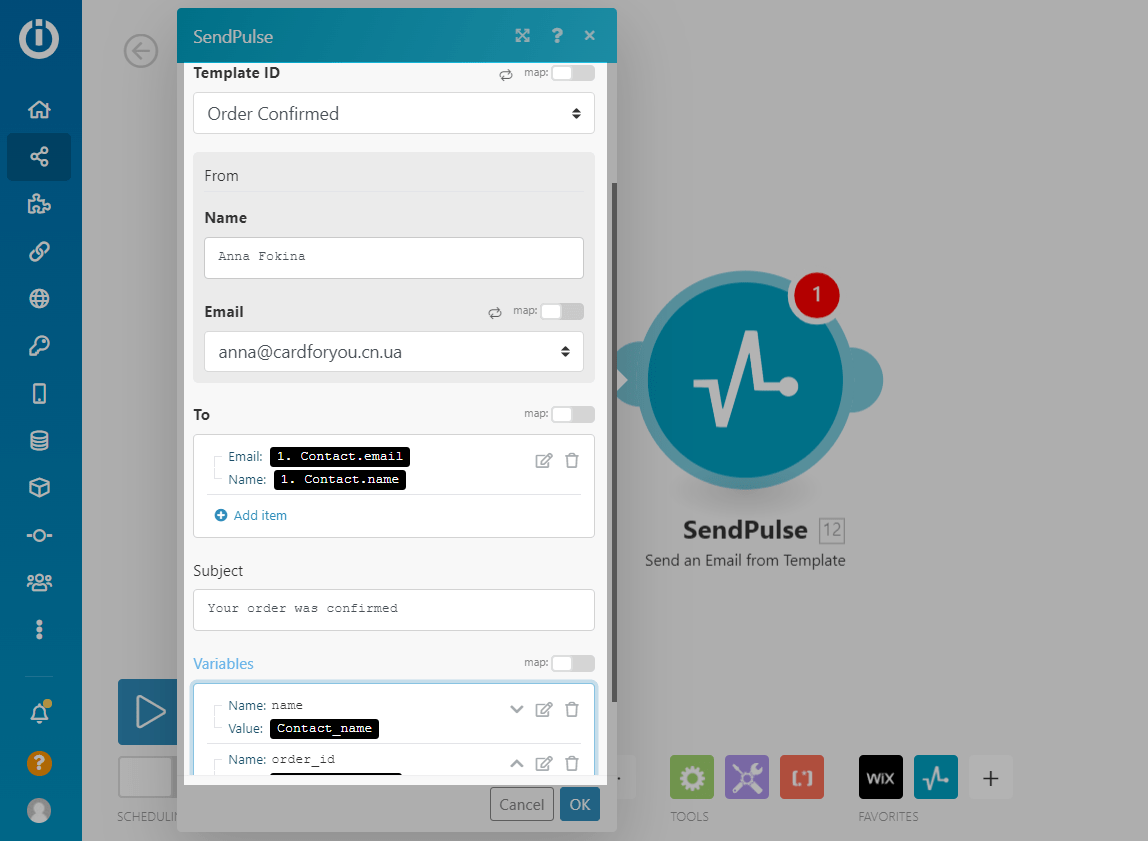
You can check the module the same way you check the execution of the element.
Using the manual method
To use a search method from the SendPulse API that is not on the list, select the SendPulse element with the Make API call method.
Fill in the fields, following the SendPulse API documentation on the method:
For example, use the Create deal in CRM method. In the URL field, insert the URL of the method, and select the POST method.
Note that the CRM service in SendPulse has integrations with other services in SendPulse. If you specify Create deal in CRM in the chatbot, A360, or the website builder, then launching an event or flow with this action will automatically create a deal and a contact in CRM.
This also works vice versa: if you have configured the start of the flow to create a deal or change the status in the CRM, then the creation of the deal or deal status change l will automatically trigger the message sendout.
There is no need to duplicate actions. If you need to update your existing information, use the PUT method.
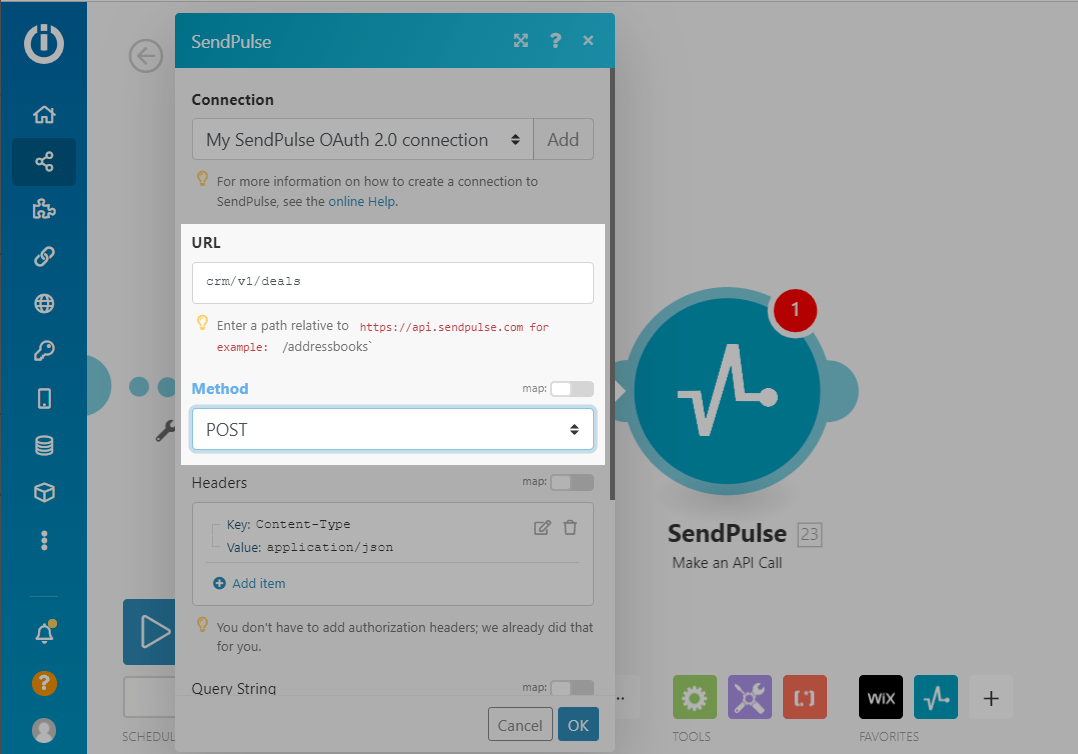
Insert the body of your query. You can get an example of the query and a description of all parameters in the method documentation.
You can insert a static variable value if you want to make queries with the same data or use dynamic values if you want to make queries with the value of the variables you got in the previous elements.
To use dynamic values, select the variable obtained in the previous scenario elements.
For most properties (which are optional) you need to specify an object ID. You can get them in previous elements since Make supports running elements sequentially.
If you don't have variables from the previous elements, click Run this module only next to it to run the element, or click Run once to run the whole flow scenario. The number next to the parameter indicates the sequence number of the element in the scenario.
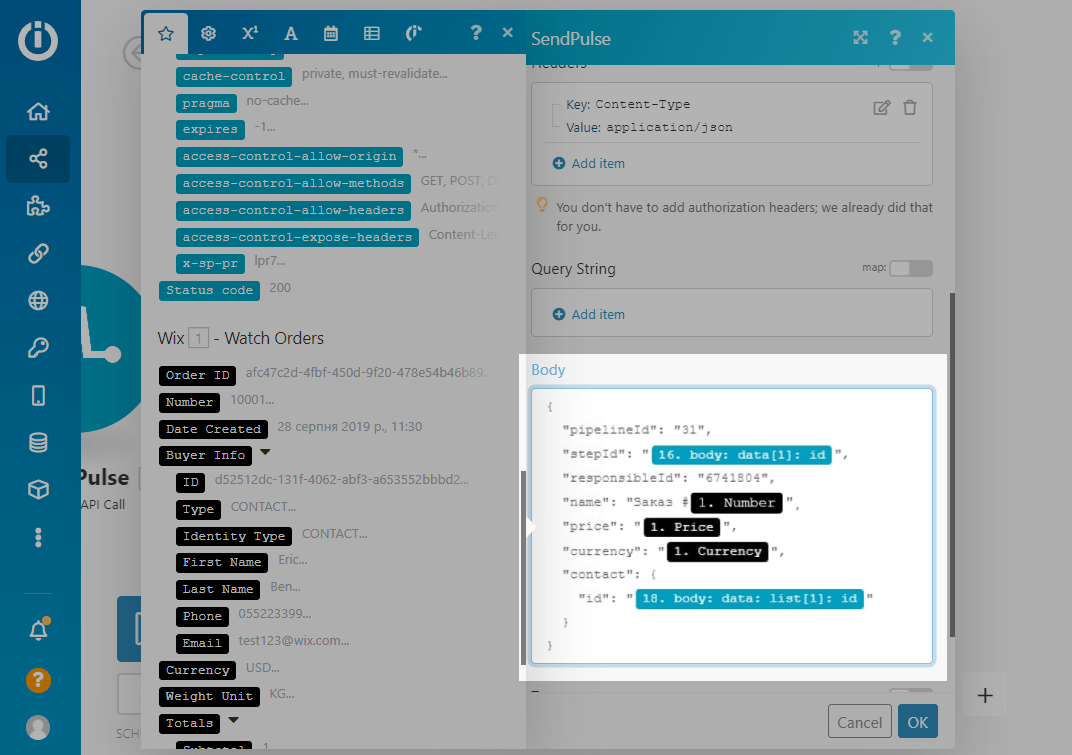
You can check the module the same way you check the execution of the element.
Here is a list of search methods that are not on the ready-made list, but you can use them as well:
| Email service | |
| Create a Mailing List | Creates a mailing list in the Email service.
Returns the mailing list ID. |
| Create a Campaign | Creates an email campaign for the specified mailing lists.
Returns the mailing ID and its cost. |
| Edit Scheduled Campaign | Updates the mailing list data. |
| Edit a Template | Updates the data according to the existing template. |
| Add a Sender | Sends confirmation to add an email address and send emails in the Email service. |
| Delete an Email Address From All Mailing Lists | Deletes an email address from all mailing lists. |
| Add an Email Address to Blacklist | Adds an email address to the blacklist so that the user stops receiving emails. |
| SMTP | |
| Add a Domain | Sends confirmation to add the domain to the SMTP settings and send emails from it. |
| Email validator | |
| Verify Mailing List | Checks email addresses in the mailing list for validity.
Returns the checked ID. To get the result of the mailing list check, use the Get Mailing List Verification Results method. |
| SMS | |
| Add Telephone Numbers to a Mailing List | Adds phones to the mailing list without or with variables. |
| Update a List of Variables for a Phone Number | Updates the variable value for the specified existing contact, specifying the variable type. |
| Update a List of Variables for a Phone Number | Updates the value of the contact list variables by setting the same value for all contacts. |
| Remove Phone Numbers from a Mailing List | Removes a contact's phone number from the mailing list. If the user has other contact information, the contact will remain in the mailing list. |
| Add Phone Number to the Blacklist | Adds a contact to the blacklist so that the user stops receiving campaigns to this phone number. |
| Remove a Phone Number from the Blacklist | Deletes a contact from the blacklist. |
| Create a Campaign to Mailing list | Sends an SMS message to the specified mailing list. |
| Create a Campaign for a List of Phone Numbers | Sends an SMS message to the specified number or list of numbers. |
| Cancel a Campaign Before Sending Has Started | Cancels a scheduled SMS campaign. |
| Viber | |
| Create a Viber campaign | Sends a message to the specified mailing list or the list of phone numbers in Viber. |
| Edit a scheduled Viber campaign | Edits the data of a scheduled campaign. |
| Cancel the Viber campaign | Cancels a scheduled campaign. |
| CRM | |
| Create a new pipeline | Creates a new pipeline with pipeline stages in the CRM service.
Returns pipeline ID and setup information. |
| Update information about a pipeline | Updates the settings of the specified pipeline. |
| Create a new deal | Creates a new deal with the specified properties.
Returns a copy of the pipeline ID information. You can use it to get the |
| Update information about deal | Updates the information on the specified deal. |
| Delete a pipeline | Deletes the selected pipeline. |
| Add a note to the deal | Adds a comment to the specified pipeline.
Returns comment ID. |
| Update a note to a deal | Updates the selected comment in the specified pipeline. |
| Delete comment | Deletes a comment in the specified pipeline. |
| Create a new contact | Creates a contact with the specified properties in the pipeline.
Returns a copy of the contact ID information. You can use it to get the |
| Update information about contact | Updates the properties of the specified contact. |
| Remove contact | Removes the contact from the pipeline. |
| Add a note to a contact | Adds a comment to the specified contact's card.
Returns the comment ID. Updating and deleting an object by analogy. |
| Add a phone to a contact | Adds a phone number to the specified contact card.
Updating and deleting an object by analogy. |
| Add an email to a contact | Adds an email address to the specified contact's card.
Updating and deleting an object by analogy. |
| Add a messenger to a contact | Adds a contact's login in the specified messenger to the specified contact's card.
Updating and deleting an object by analogy. |
| Create a tag | Creates a tag for contacts.
Returns the tag ID. Updating and deleting the object by analogy. |
| Add a tag to the contact | Adds a tag to the specified contact's card. |
| Add a field to the deal | Adds a field to the specified pipeline.
Updating and deleting an object by analogy. |
| Add a field to a contact | Adds a field to the specified contact
Updating and deleting an object by analogy. |
| Chatbots
*The methods used for all messengers (Instagram, Telegram, Facebook, or WhatsApp) are identical. However, there are additional methods for some messengers. |
|
| Remove a tag from a contact | Deletes a tag of the specified contact. |
| Mark messages as read | Marks all contact messages as read. |
| Disable contact | Disables the sendout of campaigns and flows to certain contacts in the audience. |
| Enable contact | Resumes campaigns and flows. |
| Pause autoflows for contact | Pauses the chatbot flows for the specified contact for 60 minutes. |
| Resume autoflows for a contact | Reactivates flows for contacts. |
| Start the flow by trigger | Starts a flow for the specified contact by keyword. |
Additional features in Make
Make also has additional tools for data processing. For example, you can use Filter to filter your received data, use Router to branch scenarios, use Aggregator and Iterator to combine and merge your received data, and use built-in tools to format data within each field.
Have a look at some examples of use in the articles: How to Send a WhatsApp Chatbot Message Triggered by an Event via Make, How to Create a Chatbot with a Booking System in Google Sheets, and How to Transfer Data from a Chatbot to Google Apps.
Last Updated: 19.04.2024
or